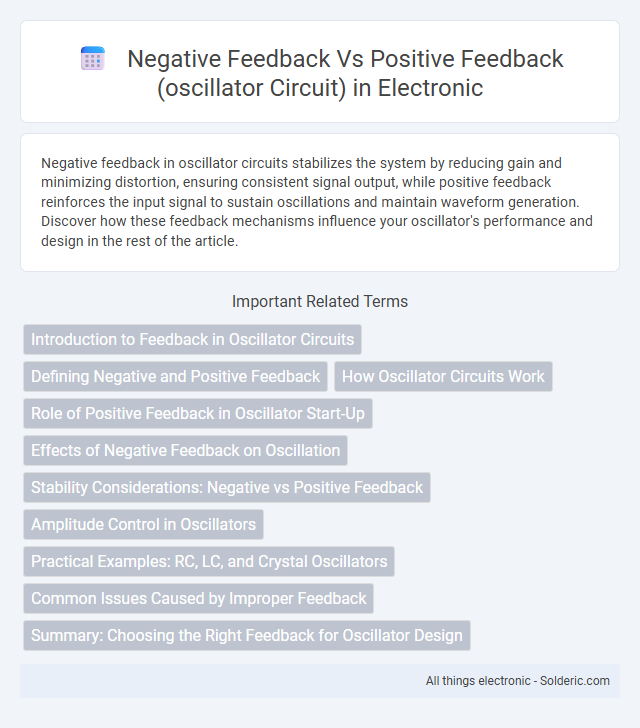Negative feedback in oscillator circuits stabilizes the system by reducing gain and minimizing distortion, ensuring consistent signal output, while positive feedback reinforces the input signal to sustain oscillations and maintain waveform generation. Discover how these feedback mechanisms influence your oscillator's performance and design in the rest of the article.
Comparison Table
| Feature | Negative Feedback | Positive Feedback |
|---|---|---|
| Purpose | Stabilizes gain, reduces distortion | Sustains oscillations in circuits |
| Phase Shift | 180deg phase shift with inversion | No inversion or 0deg phase shift |
| Gain Effect | Decreases overall gain | Increases overall gain to maintain oscillation |
| Stability | Improves circuit stability | Can cause instability for sustained oscillations |
| Application in Oscillator Circuit | Used to control amplifier behavior | Essential for generating and maintaining oscillations |
| Effect on Output | Reduces noise and distortion | Produces continuous output waveform |
| Feedback Type | Subtractive feedback | Additive feedback |
Introduction to Feedback in Oscillator Circuits
Feedback in oscillator circuits regulates signal amplification and stability through two main types: negative and positive feedback. Negative feedback reduces gain to stabilize the output frequency, minimizing distortion and preventing oscillation collapse. Positive feedback reinforces the signal, enabling sustained oscillations essential for generating stable waveforms in Your oscillator design.
Defining Negative and Positive Feedback
Negative feedback in oscillator circuits reduces the overall gain by feeding a portion of the output signal back in opposite phase to the input, stabilizing the system and minimizing distortion. Positive feedback, conversely, reinforces the input signal by feeding back a portion of the output in phase, which is essential for sustaining oscillations in the circuit. Understanding these feedback types helps you design oscillators with desired stability and signal clarity.
How Oscillator Circuits Work
Oscillator circuits generate continuous waveforms by using positive feedback to reinforce signal amplitude and maintain oscillations. Negative feedback in oscillator circuits stabilizes the output by reducing distortion and controlling gain, ensuring a steady frequency. The balance between positive and negative feedback determines the oscillator's stability, frequency accuracy, and waveform purity.
Role of Positive Feedback in Oscillator Start-Up
Positive feedback in oscillator circuits plays a crucial role in initiating oscillations by reinforcing the signal and overcoming losses within the circuit. When the feedback is positive, it amplifies the initial noise or small signal, allowing the oscillator to reach the threshold necessary for sustained oscillation. Your circuit depends on this mechanism to ensure stable start-up and continuous waveform generation without external input.
Effects of Negative Feedback on Oscillation
Negative feedback in an oscillator circuit reduces gain and stabilizes amplitude, preventing distortion and ensuring consistent waveform quality. It suppresses unwanted noise and harmonics, enhancing signal purity and overall performance. Your oscillator benefits from improved frequency stability and reduced sensitivity to component variations with properly applied negative feedback.
Stability Considerations: Negative vs Positive Feedback
Negative feedback in oscillator circuits enhances stability by reducing gain variations and suppressing noise, thereby maintaining consistent amplitude and frequency. Positive feedback, essential for oscillation initiation, can lead to instability if not carefully controlled, causing amplitude to increase uncontrollably or oscillations to distort. Proper design balances these feedback types to achieve stable, sustained oscillations without compromising signal integrity.
Amplitude Control in Oscillators
Negative feedback in oscillator circuits stabilizes amplitude by reducing gain when the output signal grows, preventing distortion and clipping. Positive feedback reinforces the signal, enabling continuous oscillation but requires precise control to avoid amplitude runaway. Implementing controlled negative feedback loops ensures consistent amplitude levels, enhancing signal quality and oscillator performance.
Practical Examples: RC, LC, and Crystal Oscillators
In oscillator circuits, negative feedback stabilizes the output by reducing distortion, as seen in RC oscillators used for audio frequency generation and signal conditioning. Positive feedback, essential for oscillation, is implemented in LC oscillators, such as in radio frequency applications, where inductors and capacitors create resonant circuits. Crystal oscillators use quartz crystals with positive feedback to achieve high frequency stability and precision in clock generation and communication devices.
Common Issues Caused by Improper Feedback
Improper feedback in oscillator circuits can cause instability, distortion, and failure to maintain sustained oscillations, with negative feedback often leading to signal attenuation or cutoff. Positive feedback, if excessive, may result in unwanted oscillations, increased noise, and signal clipping, degrading circuit performance. Ensuring correct feedback polarity and amplitude is essential for your oscillator to function reliably and produce a clean, stable output.
Summary: Choosing the Right Feedback for Oscillator Design
Negative feedback stabilizes oscillator circuits by reducing gain and distortion, ensuring steady oscillations and consistent frequency output. Positive feedback reinforces signal strength, enabling oscillation startup and sustained waveform generation critical for oscillator function. Your choice between negative and positive feedback depends on balancing stability and signal growth to achieve reliable and precise oscillation performance.
Negative feedback vs Positive feedback (oscillator circuit) Infographic

 solderic.com
solderic.com